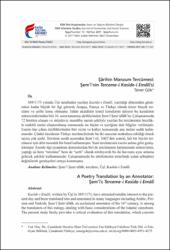Şârihin Manzum Tercümesi: Şem‘î’nin Terceme-i Kasîde-i Emâlî’si
Citation
GÖK, Taner. "Şârihin Manzum Tercümesi: Şem‘î’nin Terceme-i Kasîde-i Emâlî’si." FSM İlmî Araştırmalar İnsan ve Toplum Bilimleri Dergisi, 10 (2017): 171-204.Abstract
569/1173 yılında Ûşî tarafından yazılan Kasîde-i Emâlî, yazıldığı dönemden günümüze
kadar büyük bir ilgi görerek Arapça, Farsça ve Türkçe olmak üzere birçok tercüme
ve şerhe konu olmuştur. İslâm akaidinin temel konularını işleyen bu kasidenin
mütercimlerinden biri 16. asrın tanınmış şârihlerinden Şem‘î Şem‘ullâh’tır. Çalışmamızda
72 bentten oluşan ve müzdevic murabba nazım şekliyle yazılan bu tercümenin öncelikle
tenkitli metni oluşturulmuş sonrasında ise biçim ve içeriğine dair bilgiler verilmiştir.
Eserin öne çıkan özelliklerinden biri vezin ve kafiye konusunda ana metne sadık kalınmasıdır.
Çünkü kasidenin Türkçe tercümelerinde bu iki unsurun muhafaza edildiği örnek
sayısı çok azdır. Tercüme usulü açısından Şem‘î (ö. 1602’den sonra), her bir beytin tercümesi
için dört mısralık bir bend kullanmıştır. Yani tercümesini eserin aslına göre genişletmiştir.
Eserde ilgi uyandıran durumlardan biri de tercümenin hatimesinde mütercimin,
yaptığı işi hem “tercüme” hem de “şerh” olarak niteleyerek bu iki kavramı aynı anlama
gelecek şekilde kullanmasıdır. Çalışmamızda bu nitelemenin temelinde yatan sebeplere
değinilerek gerekçeleri ortaya konmuştur. Kasîde-i Emâlî, written by Ûşî in 569/1173, have attracted notable interest to the present
day and been translated into and annotated in many languages including Arabic, Persian
and Turkish. Şem‘î Şem‘ullâh, an acclaimed annotator of the 16th century, is among
the translators of this eulogy, dealing with basic considerations of the Islamic catechism.
The present study firstly provides a critical evaluation of this translation, which consists of
72 quadrant and penned in a prosodic (aruz) versification called “müzdevic murabba”
(i.e. rhyming four lines), and then offers some formal and contentual information. One of
the prominent characteristics of this work, standing out among the Turkish translations of
the eulogy with its peculiar features, is its loyalty to the source text’s metric and rhyming
properties. There are few Turkish translations of the eulogy having observed these two
features. It was found out that Şem‘î, as a translational style, chose to provide details in
several couplets rather than preserve the couplets as they are. In other words, he translated
each couplet in two couplets. One of the interesting features of the work is the fact
that the translator refers to its practice as both a “translation” and an “annotation” in the
epilogue, thusly uses these two terms as synonyms. Relatedly, this study reveals the facts
concerning this characterization by discussing the underlying reasons.



















